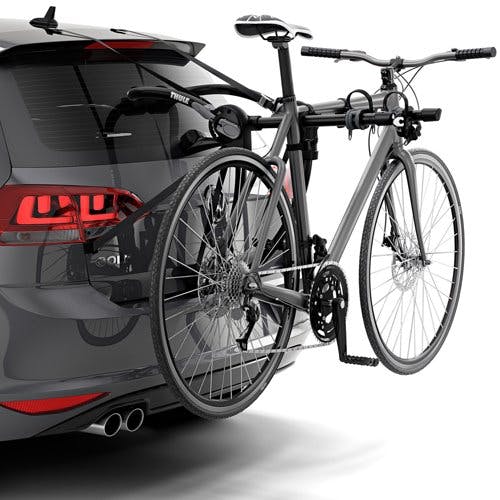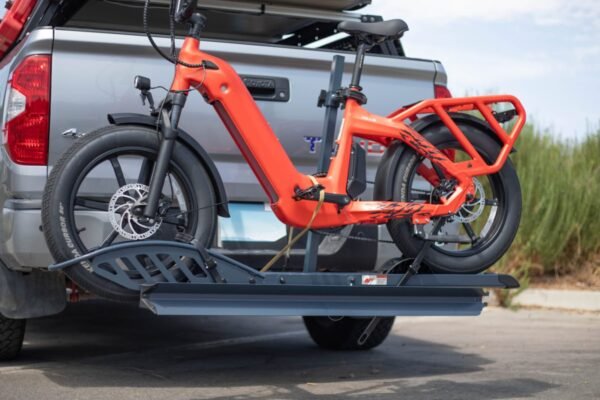Top Queries: Do You Really Need a Specialized E Bike Rack?
Explore the Various Kinds of Bike Rack and Their Practical Applications for Biking Enthusiasts
The range of bike Racks readily available today satisfies the diverse demands of biking fanatics. From freestanding to wall-mounted options, each layout supplies distinct advantages for storage and transport. Mobile Racks additionally offer adaptability for those on the move. Choosing the optimal type requires careful consideration of details demands. Recognizing these variables can make a considerable difference in both convenience and safety for cyclists. What are the key considerations when choosing a bike rack?
Comprehending Bike Rack Types
Various sorts of bike Racks provide to the varied requirements of bikers. Among the most typical are freestanding racks, commonly found in metropolitan locations, which permit multiple bikes to be secured in a portable area. Wall-mounted Racks serve those with limited floor room, providing an efficient solution for home storage space. Furthermore, mobile bike shelfs, developed for ease of transportation, charm to bikers that frequently take a trip.

Hitch-Mounted Bike Racks
Hitch-mounted bike Racks use a functional service for carrying bicycles, however understanding their setup procedure is necessary for efficient usage. Individuals should additionally take into consideration the weight capability of these Racks to guarantee safety and security and stability while taking a trip. In addition, compatibility with numerous car types plays a significant role in establishing the appropriate rack for individual demands.
Installment Refine Overview
When selecting a hitch-mounted bike rack, recognizing the installation process is essential for ensuring safety and security and benefit. Initially, the individual should validate compatibility in between the rack and the automobile's drawback receiver. Most Racks are developed for either 1.25-inch or 2-inch receivers. After picking the suitable shelf, the installation starts with protecting the rack right into the drawback receiver and tightening up the hitch pin or bolt to stop motion. Correct positioning is critical to ascertain the shelf does not obstruct tail lights or license plates. As soon as installed, it is recommended to examine for stability by applying mild stress to the shelf. Following the manufacturer's directions will certainly guarantee an effective installation, promoting a safe cycling experience when traveling.
Weight Ability Considerations

Compatibility With Car Kind
Choosing the ideal bike shelf entails validating compatibility with numerous vehicle types. Hitch-mounted bike Racks are designed to connect to the back drawback receiver of a vehicle, making them ideal for a wide range of vehicles, suvs, and cars and trucks. Nevertheless, it is important to check the drawback class and weight ability to confirm an appropriate fit. A lot of hitch-mounted Racks are compatible with 1.25-inch and 2-inch receivers, accommodating cars outfitted with suitable towing abilities. Additionally, customers need to consider their car's height and design, as some Racks may block rear access or require added clearance. Inevitably, recognizing lorry requirements validates that cycling lovers can securely deliver their bikes without compromising safety and security or functionality.
Trunk-Mounted Bike Racks
Trunk-mounted bike Racks provide a sensible service for bicyclists seeking an effective way to carry their bikes. Understanding the installment process is important for optimal usage, as inappropriate configuration can bring about safety problems. Furthermore, taking into consideration the weight capability of these Racks guarantees that they can firmly hold the bikes without threat of damage or failing during transit.
Installment Process Review
Numerous biking enthusiasts value the benefit of trunk-mounted bike Racks for their ease of use and versatility. The setup procedure generally starts with familiarizing and unpacking the rack oneself with its components. Many Racks include adjustable straps and hooks created to secure them to the vehicle's trunk or hatch. Customers ought to verify the shelf is located appropriately, straightening it with the lorry's shapes for stability. Complying with the supplier's instructions, the straps are then tightened safely, assuring a snug fit. It is essential to examine that the rack does not block the vehicle's lights or permit plate. Ultimately, validating that all connections are secure prior to loading bikes is vital for secure transport. Correct installment improves both safety and efficiency throughout biking journeys.
Weight Capability Considerations
When taking into consideration a bike rack for carrying bicycles, weight capacity is an essential aspect that can not be forgotten. Trunk-mounted bike Racks typically have weight limits that differ relying on the model and layout. It is crucial for users to examine these specs to ensure they do not surpass the suggested weight, as doing so can compromise both security and car honesty. Many trunk-mounted Racks can sustain 1 or 2 bikes, with a mixed weight capacity varying from 70 to 120 extra pounds. Bicyclists ought to additionally think about the weight of their bikes, especially if they possess heavier models like electrical bikes. Effectively matching the shelf's weight ability with the bikes' weights ensures a safe and secure and safe transportation experience.
Roof-Mounted Bike Racks
Roof-mounted bike Racks use a structured remedy for transferring bicycles, supplying cyclists with the advantage of making best use of cargo space. These Racks are developed to hold bikes securely atop the lorry, enabling easy access to the rear of the auto and protecting against blockages to the license plate or tail lights. They are perfect for people that regularly travel with their bikes, as they can fit different bike styles and dimensions.
Installment commonly includes affixing the rack to the automobile's bars, guaranteeing a stable and risk-free fit. Roof-mounted Racks are frequently aerodynamic and lightweight, which can bring about boosted gas effectiveness compared to other kinds of racks. However, users need to take into consideration the elevation of their car when loading and dumping bikes, along with potential obstacles when entering garages or low-clearance areas. On the whole, roof-mounted bike Racks use a flexible and efficient alternative for passionate bicyclists on the go
Wall-Mounted Bike Racks
Wall-mounted bike Racks provide an effective solution for bicyclists seeking to take full advantage of restricted space while safely saving their bicycles. These Racks are ideal for city occupants or those with small garages, as they raise bikes off the ground and utilize upright room. Made from tough materials, wall-mounted options can fit different bike kinds, including road, hybrid, and hill bikes.
Installation is uncomplicated, allowing customers to place them in garages, basements, and even outdoor rooms. Many designs enable one or multiple bikes, making them flexible for specific or family members use. Additionally, some wall-mounted Racks featured integrated locks or protection functions to deter theft, boosting comfort for cyclists.
Portable Bike Racks
Portable bike Racks provide bicyclists a practical and flexible option for carrying their bicycles. These Racks are developed for very easy installation and elimination, making them optimal for those that require to often switch over in between lorries or areas. Small and normally light-weight, portable bike Racks can be easily stored in a trunk or garage, easing the burden of irreversible installations.
There are numerous kinds of mobile bike shelfs, including hitch-mounted, trunk-mounted, and roof-mounted options, each dealing with different automobile types and bicyclist choices. Hitch-mounted Racks offer security and accessibility, while trunk-mounted Racks are commonly much more affordable and functional. Roof-mounted Racks are excellent for taking full advantage of cargo room yet might need some training.
Selecting the Right Bike Rack for Your Demands
Just how can one identify the best bike shelf to fit their specific biking requirements? Identifying the right bike rack involves assessing a number of aspects. One need to consider the type of lorry used for transportation, as Racks are developed for various installing systems, such as hitch, roof covering, or trunk. Next, the number of bikes to be carried is vital; some Racks suit just one, while others can hold multiple bikes effectively. In addition, determining the weight and structure style of the bikes is substantial, as specific Racks are better matched for heavier or distinctively designed bikes. Ultimately, designated use needs to be taken into consideration; constant vacationers may favor a much more portable choice, while occasional users could focus on simplicity and convenience of installation. By thoroughly considering these factors to consider, people can pick a bike rack that fulfills their requirements and boosts their cycling experience.

Frequently Asked Questions
Can Bike Racks Accommodate Different Bike Sizes and Styles?
Bike Racks vary in layout, making it possible for accommodation for different bike sizes and designs. Some Racks feature adjustable parts, while others are especially customized for sure bikes, guaranteeing safe and secure storage and easy access regardless of the bike's requirements.
How Do I Effectively Protect My Bike on a Shelf?
To effectively protect a bike on a rack, one should assure the framework and wheels are firmly attached using locks or straps, checking for security and stopping movement during transport to stay clear of damage.
Are Bike Racks Easy to Get Rid Of and mount?
Bike Racks vary in installment complexity, however numerous are designed for user-friendliness. Detachable designs generally provide simple arrangement and elimination, while long-term installments might require tools and even more time, depending on the details design.

What Products Are Bike Racks Generally Made From?
Bike Racks are generally made from materials such as steel, plastic, and aluminum. E Bike Rack. Steel offers longevity and strength, while light weight aluminum provides lightweight portability. Plastic alternatives are often developed for ease of usage and price
Do Bike Racks Affect Gas Efficiency When Driving?
When driving is substantial, the question of whether bike Racks affect gas efficiency. Studies show that bike Racks can enhance wind resistant drag, possibly bring about lowered fuel efficiency, particularly at greater rates or with added weight.
After selecting the appropriate rack, the installment starts with protecting the Hitch Bike Rack rack into the hitch receiver and tightening up the hitch pin or screw to avoid movement. Roof-mounted Racks are lightweight and usually aerodynamic, which can lead to improved gas effectiveness compared to other kinds of shelfs. Hitch-mounted Racks offer stability and availability, while trunk-mounted Racks are usually extra economical and functional. Next off, the number of bikes to be brought is crucial; some Racks accommodate just one, while others can hold multiple bikes successfully. Bike Racks vary in design, enabling accommodation for different bike sizes and designs.